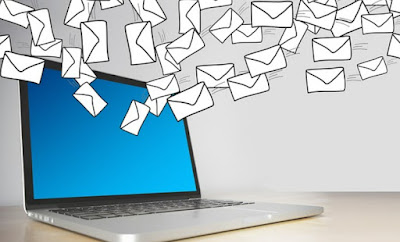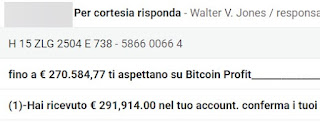
Spam and scam emails are a constant in every mailbox, even the least used one: in a short time, a large part of the memory space reserved for our mailbox will be filled with many useless and often harmful messages. These messages are usually deleted automatically by Gmail or by the chosen provider, but many messages escape the automatic filtering system because they are so well built that they fool the filters, exposing unsuspecting users to very serious dangers.
In the following guide we will try to show you the titles and words used in Italian scam and spam emailsso as to know in advance what to avoid (and immediately report as spam) and what is better to continue reading.
READ ALSO -> Best anti-spam services to protect corporate and web email
Winning messages
The most common scam messages concern the winning a certain amount of money (always very tall and that oddly it almost always starts with a 2), also accompanied by emojis and the use of sensational and triumphal tones, to entice the user to open the email and click where desired.
Who would ever bother to give us 200,000 euros like this these days? To avoid this type of scam, just pay attention to the title (where large sums of money are displayed) and the words used in the message body, which often also contain images of famous institutions or banks.
This type of message often arrives in English or, when the Italian language is used, it is always very elementary or full of too trivial errors.
Amazon messages
Spam emails associated with Amazon are on the rise, as it is highly likely to find a user who has an Amazon account or a Amazon Prime subscription.
The more harmless messages contain titles and words like “Amazon has a surprise”, “Regalo Amazon” O “Free Amazon Coupons”while messages to pay close attention to contain devious words such as “Amazon Expiration Notice”, “New Amazon package” O “Amazon package is coming”, all very difficult to intercept if we are novice users. The most dangerous emails hide phishing and links to viruses, so always pay close attention when opening messages.
In these emails, the use of Italian is always very elementary, but definitely more precise than common spam (as well as Amazon logos and images).
Cryptocurrency messages
Cryptocurrencies such as Bitcoin have also ended up in the crosshairs of spammersas a valid argument to convince unsuspecting users to click on links or even just open the scam email.
Cryptocurrency messages tend to be very difficult to intercept, especially if we are already interested in Bitcoin or already have cryptocurrencies in our e-wallet. In this case we will have to pay close attention to messages relating to the transfer of Bitcoinswinnings of large sums of Bitcoin and invitations to withdraw Bitcoins for free (which is impossible).
These messages are rarely in Italian and, when they use Dante’s language, there are really too many errors in the title or in the content to not notice.
Messages about money transfer
Another very common category of messages in spam and scam messages are those relating to “money transfer”, ie messages in which it is clearly written that we have to receive a sum of money or that a transfer is pending confirmation.
As already seen for spam messages on winnings the titles and words used often are “Payment approved”, “Successfully Received” e “We have trasferred”; if they use Italian, the most used phrase is undoubtedly “You have received” or “The payment is added to the account”.
Since these messages are hardly in Italian, it is better to trash them immediately as soon as they arrive, so as not to run any risk.
Account messages or blocked transfers
Even today spam messages about blocked accounts or transfers represent the best way to make users fall into the phishing.
In these messages we almost always find the writing “will be deleted within”, necessary to instill fear in the user and force him to click on the malicious or phishing link. In the past, a fake post office site and a message about the blocking of Postepay or the BancoPosta account, but in most cases the messages concern accounts with a lot of money that will be deleted within 48 hours if we don’t click right away.
Compared to the other messages seen so far, the use of Italian is abundant and the number of errors reduced to a minimum, so as to be able to deceive a careless eye or a novice user with a PC or a modern smartphone.
Other spam techniques to know
In addition to the very particular messages seen in the previous chapters, we must pay attention to messages that have the following characteristics, often used in spam emails:
- Email without subject: the most elementary spam systems look for spam by filtering the subject, that is the field where you enter what the email contains. Spammers can also send emails without subject, by leveraging the first words in the body of the message. This can fool spam filters and trap an unsuspecting user.
- Verify password: another spam phishing email, where the most famous accounts are often used to try to quickly recover the password. If we have not actually asked for a password change, we can ignore the email or check directly on the offending site if a unauthorized access.
- Shared files: among the widespread spam techniques we also find the sharing of files from Google Drive or attachments to download, which often contain malware capable of turn any PC into a botnet.
- Image-only emails: if there is no text in the body in the message and we only find images (blocked by almost all email providers), we absolutely avoid unblocking them as they often contain hidden links and scripts that start automatically.
By following the directions we will have to be able to avoid most of the spam that arrives daily in mailboxes all over the world.
Conclusions
Spam is really hard to fight, so it is best to always be up to date on the new techniques used by spammers, especially the words and texts they use to try to deceive users. Whatever the message received, just follow always 3 golden rules to avoid spam: Messages that require immediate and urgent action, messages that generate panic, and messages that promise winnings are always spam, so we don’t even have to open them.
If we use Gmail it is really very simple block spam emailsjust as it is simple to obtain spam blocking services and programs that escapes the automatic filters.





